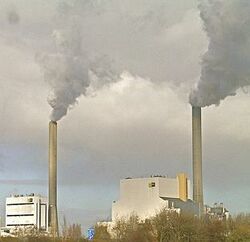ADMS atmospheric dispersion modeling system
The ADMS atmospheric dispersion modeling system is an advanced air pollution dispersion model[1][2][3] for calculating the concentrations of air pollutants emitted both continuously from point, line, volume and area sources, or intermittently from point sources.[4] It was developed by Cambridge Environmental Research Consultants (CERC) of the United Kingdom (UK) in collaboration with the UK's Met Office and the University of Surrey.
The ADMS suite of models
The first version of ADMS was released in 1993 and the current version 4 was released in 2007. Currently, ADMS is comprised of a suite of models:[4]
- ADMS 4: Modeling the dispersion of industrial air pollution emissions.
- ADMS-Screen: Screening model for industrial air pollution emissions.
- ADMS-Urban: Managing air quality for urban planning and reviews.
- ADMS-Roads: Modeling the dispersion of air pollutant emissions from road traffic.
- ADMS-Airport: Modeling the dispersion of air pollutant emissions from airplane traffic at airports.
- ADMSSTAR: Modeling the dispersion of short-term accidental radioactive releases.
- ADMS-Fire: Modelling the dispersion and deposition of air pollution from fires.
Typical applications
ADMS 4 is the primary tool used for modeling of the environmental impact of air pollution emissions from existing or proposed industrial facilities. It can also be used to assess air quality with respect to the air quality standards such as the European Union Air Quality Directive,[5] the UK Air Quality Strategy,[6] the U.S. National Ambient Air Quality Standards (NAAQS) and the World Health Organization (WHO) Air Quality Guidelines.[7] Some typical applications are:
- Demonstrating compliance with the UK Integrated Pollution Prevention and Control (IPPC) regulations[8]
- Stack height determination,
- Odor modeling,
- Environmental impact assessments
- Safety and emergency planning
Features and capabilities
The ADMS 4 model includes algorithms which take into account: downwash effects of nearby buildings within the path of the dispersing pollution plume; effects of complex terrain; effects of coastline locations; wet deposition, gravitational settling and dry deposition; short term fluctuations in pollutant concentration; chemical reactions; radioactive decay and gamma-dose; pollution plume rise as a function of distance; jets and directional releases; averaging time ranging from very short to annual; and condensed plume visibility. The system also includes a built-in meteorological data input preprocessor which allows a variety of input meteorological data.[9][10]
The model is capable of simulating passive or buoyant continuous plumes as well as short duration puff releases. It characterizes the atmospheric turbulence by two parameters, the boundary layer depth and the Monin-Obukhov length, rather the single parameter Pasquill class.[9][10]
ADMS 4 can model up to 300 emission sources, of which:[9]
- up to 300 may be point sources
- up to 30 line sources, 30 area sources and 30 volume sources, may be modeled simultaneously
The performance of the model has been validated against more than 15 measured dispersion data sets.[11]
Users of the ADMS suite of models
The users of ADMS include:
- UK governmental regulatory authorities including the UK Health and Safety Executive (HSE)
- UK Environment Agency of England and Wales
- Over 130 individual company license holders in the UK
- Scottish Environment Protection Agency (SEPA) in Scotland
- Environment and Heritage Service in Northern Ireland
- Governmental organizations including the Food Standards Agency (UK)
- Users in other European countries, Asia, Australia and the Middle East
- Accepted by U.S. EPA as an "Alternative" model[12]
References
- ↑ D.B. Turner (1994). Workbook of Atmospheric Dispersion Estimates, 2nd Edition. CRC Press. ISBN 1-56670-023-X. www.crcpress.com
- ↑ Karl B. Schnelle and Partha R. Dey (2000). Atmospheric Dispersion Modeling Compliance Guide, 1st Edition. McGraw-Hill Professional. ISBN 0-07-058059-6. Available online at Google Books
- ↑ Beychok, Milton R. (2005). Fundamentals of Stack Gas Dispersion, 4th Edition. author-published. ISBN 0-9644588-0-2. www.air-dispersion.com
- ↑ Jump up to: 4.0 4.1 The ADMS software suite From the website of the Cambridge Environmental Research Consultants (CERC)
- ↑ New Air Quality Directive From the European Union's website
- ↑ Air Quality from the website of the UK's Department for Environment, Food and Rural Affairs
- ↑ Air Quality Guidelines For Europe From the website of the World Health Organization
- ↑ IPCC Information
- ↑ Jump up to: 9.0 9.1 9.2 ADMS 4 Technical Specification
- ↑ Jump up to: 10.0 10.1 MDS - Model Documentation System From the website of the European Environment Information and Observation Network (EIONET)
- ↑ Model Documentation; Validation Studies
- ↑ Alternative models From the website of the U.S. EPA
